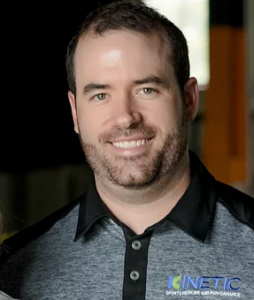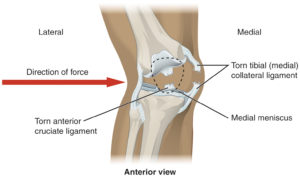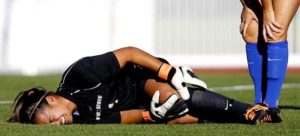By Dr. Michael Falk, PT, DPT, ATC, CSCS, special to SportsMD.com

In almost any study that looks at injury risk, the number 1 injury predictor is a previous injury. This fact is true for injuries from muscle strains to major surgical conditions such as an ACL repair. After returning to play following an ACL injury, studies show a 30 percent chance of injuring your opposite ACL or re-tearing the same ACL within 2 years.1 Even more concerning, only 55 percent of athletes return to their previous level of performance after an ACL injury.2 These statistics are mind boggling – half of the people who have ACL surgery don’t return to their prior level of play? And of those who do return to play, 1 out of 3 will injure the same-side ACL or their opposite-side ACL? How is this possible?

Many factors can contribute to these bad outcomes. Some things we cannot modify, like the role genetics may play in torn ACL injuries, or the specific anatomy of your knee joint and how that could increase your risk of re-injury. However, we can modify how we return athletes to play with a complete rehabilitation program and objective testing to measure their capability before we clear them to play.
Here are the stats on the current state of return-to-play testing following ACL Surgery:
- At the time of their return to play clearance, only 14% of athletes passed the most basic objective measurements recommended for return to play4
- Passing basic return to play testing protocols can reduce your risk of re-injury by 84%
- Despite this information, in a survey, 87 percent of clinicians stated they do not use any objective measurement before clearing people to return to play3
- A lot of Return to Play decisions rely solely on timeframes, and research has consistently shown that there is no correlation between functional ability and time after surgery5
What Should I Test Before Return to Play?
 Research indicates that a battery of tests performs better than any one individual test. Questionnaires that evaluate how confident you are in your knee coupled with basic measurements like quadriceps strength, hamstring strength and knee range of motion are an important place to start.
Research indicates that a battery of tests performs better than any one individual test. Questionnaires that evaluate how confident you are in your knee coupled with basic measurements like quadriceps strength, hamstring strength and knee range of motion are an important place to start.
After passing basic tests like these, the next step should include some type of functional testing that looks at power and the ability to control the body while on one leg. Hop tests for distance on one leg, timed agility tests comparing one side to the other, or using a technology like force plates to assess performance during explosive jumping tasks are good examples of functional tests.
Does Time Matter at All in ACL Rehabilitation?
 It is true that the ACL graft will continue to strengthen over time and it does take time to recover strength and power. One study shows a 51 percent reduction in re-injury risk for every month an athlete waits to return-to-sport (up until 9 months.) However, time alone is not sufficient. In my view, it is a mistake to make return-to-play decisions based on time alone. A recent research review looked at cases of patients who were at 6 months following their ACL reconstruction surgery. At this interval, 35.7% of patients had achieved 90% symmetry on their quadriceps strength, 47.3% had achieved 90% symmetry on their hamstring strength and 67.9% had achieved 90% symmetry on a single-leg hop test. So, 180 days of elapsed time did not result in full recovery from the injury, and yet, many athletes have already been discharged from physical therapy and are looking to return to their sport at this time. This research shows that the vast majority of athletes still have significant deficits and would benefit from a structured program before they return to sport.
It is true that the ACL graft will continue to strengthen over time and it does take time to recover strength and power. One study shows a 51 percent reduction in re-injury risk for every month an athlete waits to return-to-sport (up until 9 months.) However, time alone is not sufficient. In my view, it is a mistake to make return-to-play decisions based on time alone. A recent research review looked at cases of patients who were at 6 months following their ACL reconstruction surgery. At this interval, 35.7% of patients had achieved 90% symmetry on their quadriceps strength, 47.3% had achieved 90% symmetry on their hamstring strength and 67.9% had achieved 90% symmetry on a single-leg hop test. So, 180 days of elapsed time did not result in full recovery from the injury, and yet, many athletes have already been discharged from physical therapy and are looking to return to their sport at this time. This research shows that the vast majority of athletes still have significant deficits and would benefit from a structured program before they return to sport.
So, What Should We Do Now?

If you are an athlete (or parent of an athlete), develop your return-to-play testing plan before you have the surgery done. Get the surgeon and the PT to agree on what they are going to measure before you will be cleared to play.
If you are a coach of an injured athlete, ask your athletic trainer to see the return-to-play testing results before you put the athlete back in the game.
If you are a PT treating injured athletes, develop your own objective measurement capabilities to better serve your patients, or develop referral sources to have your athletes tested. The tools are readily available in your area. The results will be clear in the successful outcomes for your athletes.
References:
- Paterno MV, Rauh MJ, Schmitt LC, Ford KR, Hewett TE. Incidence of Second ACL Injuries 2 Years After Primary ACL Reconstruction and Return to Sport. The American journal of sports medicine. 2014;42(7):1567-1573. doi:10.1177/0363546514530088
- Ardern CL, Taylor NF, Feller JA, et al. Fifty-five per cent return to competitive sport following anterior cruciate ligament reconstruction surgery: an updated systematic review and meta-analysis including aspects of physical functioning and contextual factors. Br J Sports Med 2014;48:1543-1552.
- Factors Used to Determine Return to Unrestricted Sports Activities After Anterior Cruciate Ligament Reconstruction. Barber-Westin, Sue D. et al. Arthroscopy , Volume 27 , Issue 12 , 1697 – 1705
- Young Athletes Cleared for Sports Participation After Anterior Cruciate Ligament Reconstruction: How Many Actually Meet Recommended Return-to-Sport Criterion Cutoffs? Journal of Orthopaedic & Sports Physical Therapy 2017 47:11, 825-833
- Myer GD, Martin L, Ford KR, et al. No Association of Time From Surgery With Functional Deficits in Athletes After Anterior Cruciate Ligament Reconstruction: Evidence for Objective Return-to-Sport Criteria. The American journal of sports medicine. 2012;40(10):2256-2263. doi:10.1177/0363546512454656.
- Cristiani, R., Mikkelsen, C., Forssblad, M. et al. Knee Surg Sports traumatol Arthrosc (2019). https://doi.org/10.1007/s00167-019-05396-4
- Grindem H, Snyder-Mackler L, Moksnes H, et al. Simple decision rules can reduce reinjury risk by 84% after ACL reconstruction: the Delaware-Oslo ACL cohort studyBritish Journal of Sports Medicine 2016;50:804-808.

